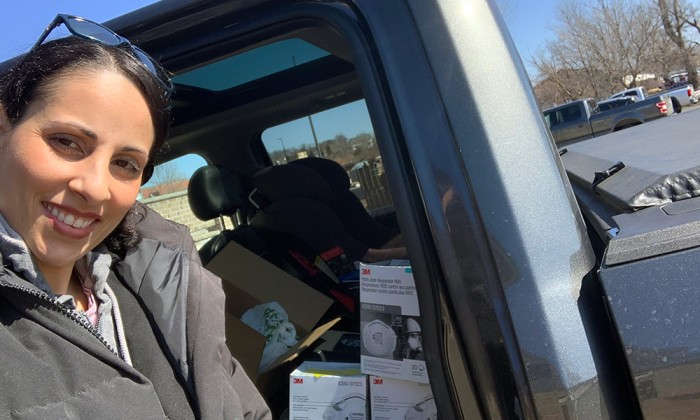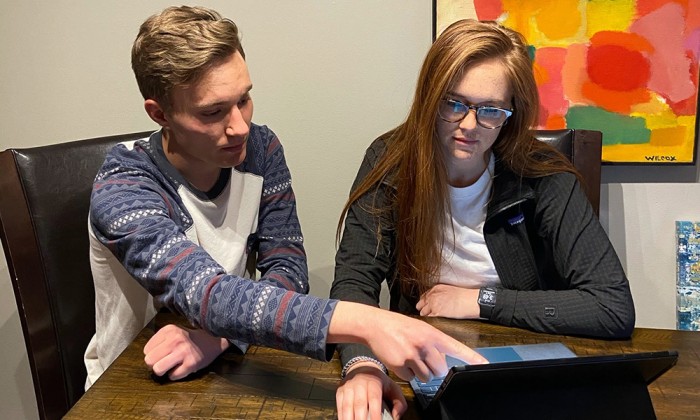
Written by Emma K. Worthington, Fourth-Year Medical Student
Ronda Farah, MD, University of Minnesota Physicians dermatologist, isn’t used to sitting on the sidelines. As the founder and director of the M Health Fairview Cosmetic Center and the Division Director of Medical Dermatology at M Health Maple Grove Specialty Clinics, the accomplished physician and researcher stays busy. So, when non-urgent procedures and office visits were indefinitely postponed in early March due to COVID-19, Dr. Farah suddenly found herself with a lot of extra time and energy to devote to the problem of making sure her medical colleagues on the front lines were safe.
In the process, she found a way for medical students to learn that healthcare is delivered in many ways.
At that time, concerns about a possible shortage of personal protective equipment (PPE) were starting to emerge, and Dr. Farah didn’t like where this was headed.
“I felt for my colleagues. I can’t imagine going into a room with possible COVID-19 and not having protection,” she said. “I have an infant, a two-year-old and elderly parents. And, I’m not the type of person who just sits around. If there is a lot of negative energy around, I funnel that into something positive.”
So, Dr. Farah picked up the phone and called a construction company that had worked on her house in the past. The company eagerly offered multiple boxes of N95 masks. Within hours, Dr. Farah had picked up the masks and had dropped them off at the Emergency Department. She quickly recognized the potential in continuing these efforts.
“I realized that [masks] were just sitting in our community. We just had to find a way to get them.”

The Medical Students
That’s when she called her mentee, James Pathoulas, a third-year medical student interested in dermatology. He had been working with Dr. Farah on a number of dermatology research projects prior to the coronavirus outbreak.
Pathoulas, along with his classmate, Ally Fuher, immediately jumped into action when they heard what Dr. Farah had done. They knew exactly whom they could enlist for support: medical students.
Medical students at the U of M Medical School had just been pulled from their clinical rotations at the time, and many were desperate to help. Nearly 60 volunteered for the project. They were the perfect people for the job.
“Give a bunch of intelligent, ‘Type A’ medical students a spreadsheet, and they can do anything,” Pathoulas joked. Within the first week, they had called over 100 construction companies and had collected hundreds of masks, gloves and other PPE. Other medical students began working on efforts to 3D-print PPE with the University’s Institute for Engineering in Medicine.
Credit Where It’s Due
Meanwhile, the medical school was rapidly designing new online courses for medical students as alternatives to clinical rotations. But, as Assistant Dean for Curriculum Anne Pereira, MD, MPH, FACP, explained, they were intent on avoiding meaningless busywork.
“Our goal was to teach students about these different nuances of being a doctor while also satisfying their need to do work that matters,” Dr. Pereira said. “We wanted to give students the freedom to do that.”
Dr. Pereira worked with Dr. Farah, Pathoulas and Fuher to design a course curriculum encompassing the medical students’ efforts in collecting PPE. But, they took it one step further and gave students the freedom to create their own COVID-19-related projects; not just PPE collecting. The students ran with it.
“I wanted to empower them to carry out their own version of helping,” Dr. Farah explained. Students have designed research projects, worked on medical student mental health support and have even been encouraged to express their ideas through art.
“I feel like one of the great things that comes out of things like this is innovation and new ways of doing things. These experiences can teach students and allow them to demonstrate their competency even better than some of our standard curriculum.”
Dr. Anne Pereira
Many medical students felt helpless when they were first pulled from their clinical rotations. They wanted to help, but didn’t know how. This course has given them a way to help, Dr. Farah said. “Part of medical education is teaching students that you do have a role even if it’s not on the front lines. When you take an oath as a healthcare provider, you have a role.”